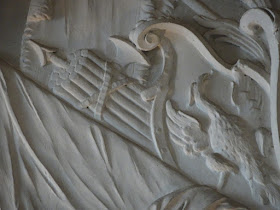 |
| The fasces symbol as an ornament | Lictors Bundle |
Since I started with my studies about ornamental wood carving, I have come across a symbol on the street, in a museum or on a furniture; a symbol to which I did not pay too much attention at the beginning.
Than since Marc van de Cruys, -editor of the magazine Heraldicum Disputationes*- has devoted an article about it, I have immersed myself in this symbol. What I discovered about the symbol turned out to be so interesting that I want to highlight it in this blog.
*Heraldicum
Disputationes is a Belgian magazine specialized in the theme of heraldry. The
magazine appears four times per year and an annual subscription cost only 20
euros.
The fasces
symbol
The symbol where
this blog is all about is the ‘fasces’ or ‘Lictors Bundle’.
The fasces
(latin, singular ‘fascis’, plural ‘fasces’) is a rod bundle, a bundle of sticks
that encloses an ax and that is tied together with a belt. If you do not know
the right meaning of this symbol, it looks like any other decorative ornament. But
on the contrary, this symbol has a unique meaning.
The rods,
usually birch but sometimes elm sticks, were a symbol of the ‘power to punish’.
The ax symbolized the ‘power over life and death’ and the red leather belts
means the ‘power to arrest’. The fasces thus symbolize the authority of the
higher magistrates and dates to the time of the ancient Romans.
Whenever
our Roman authorities made an official tour, they were preceded by the fasces
as signs of authority, carried by officials (the Lictores) . That is why the
fasces are also known as lictors bundles.
The number
of fasces carried by a magistrate corresponded to his position. For example, a
Roman consul was escorted by 12 lictors; in comparison with a praetor (kind of
judge), who was escorted by only 6 pieces.
Lictores not only served as entourage, they were also empowered with execution decision
authority, such as gaining access to buildings or opening doors and arresting
and punishing people.
Lictores
had to be free citizens, strongly built and they wore a toga (gown). The word
lictor can be derived from ‘ligare’, which has the meaning of: binding.
In the
original meaning of the fasces, the bundle of branches served to keep captured
people and the ax was used to decapitated them, if necessary.
After the 5th century, this meaning had already become to fade away, because the decision to execute could not be taken by a single magistrate. The symbolic meaning such kind of of authority stretches into our time.
After the 5th century, this meaning had already become to fade away, because the decision to execute could not be taken by a single magistrate. The symbolic meaning such kind of of authority stretches into our time.
In the
iconography, the fasces are an attribute to personified justice. Therefore,
this symbol has been introduced in the US Senate on both sides of the
President’s seat. The fasces are also the symbol of unity, for example in a
marriage. In this example, it is carried by Amor.
 |
| Entrance Château de Compiègne (FR) |
The Romans
borrowed the symbol from the Etruscans, where it was a royal symbol and more
than likely for ‘power and unity’. A single branch is easy to break; while a
bundle is virtually impossible to break in half.
When the
First French Republic was proclaimed in 1792, they reverted to the Roman
Republic, using the fasces as a symbol for the republic.
Later
During the
WWI, fascism began in the Kingdom of Italy, which started to use the rod bundle
as a symbol of national unity. Mussolini founded the Partito Nazionale Fascista
in1921 with the fasces in the party logo.
Since then, right-dictatorial regimes, based on discrimination, have been called fascist. The symbol will (like the swastika) never get rid of this negative burden.
Translation Lis Alvar R
Since then, right-dictatorial regimes, based on discrimination, have been called fascist. The symbol will (like the swastika) never get rid of this negative burden.
Translation Lis Alvar R
 |
Château de
Chantilly (FR) | Supraporte, horse stables
Right, the lictors bundle
|
 |
| Iron overdoor light in the streets of Paris. |
 |
| Symbolism in the ornamentation | Musée Des Arts Décoratifs, Paris |
 |
| Detail gilded frame | Musée Des Arts Décoratifs, Paris |
 |
| Left top of the picture, the lictors bundle | Musée Carnavalet, Paris |
 |
| Detail of buffet cupboard | Musée des Arts Décoratifs, Paris |
 |
| Paris, Musée de la Légion d'honneur et des ordres de chevalerie |
 |
| Supraporte with ornaments executed in plaster | Ansbach (Germany) Residenz |
 |
| Royal Palace Brussels | Ceiling painting trophy with attributes war |
 |
| Detail, The lictors Bundle |
 |
| Paris, the library of Richelieu | Fasces in stone |
 |
| Fasces in the streets of Paris |
 |
The New
Residence in Bamberg | The Imperial Hall (2014) | Fasces in plaster
Find the faces symbol
|







Hello
ReplyDeleteI have some pictures very similar to your Facses ornamental that I am trying to research.
They appear on a building near me, but I just cannot find enough info it it.
Could I send you some pictures for you to look at and possibly identify?
Thank you Michael
You can send them to my FB page in a private message. https://www.facebook.com/patrick.damiaens.ornamental.woodcarver
Delete